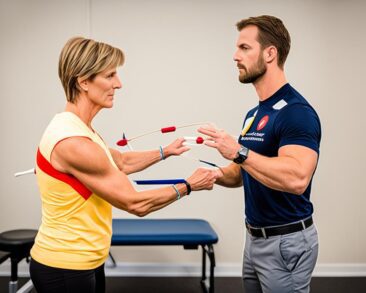Kinesiology Muscle Imbalances
Have you ever felt that your body isn’t quite aligned or experienced aches that seem to persist without a clear cause? Understanding and addressing muscle imbalance symptoms is crucial in ensuring your body functions optimally. Applied Kinesiology (AK), developed in the 1960s by Dr. George Goodheart, stands at the forefront of muscle imbalance therapy, offering a holistic lens through which to view and treat body dysfunctions.
By incorporating muscle imbalance diagnostic techniques, this science-art blend does more than assess muscle health—it peers into the interconnectedness of bodily systems. A simple muscle test might reveal hidden malfunctions in organs, nutritional deficiencies, or disruptions in your acupuncture meridians. In learning the language of your muscles, AK provides a map to your well-being, guiding towards a more balanced, pain-free life.

Key Takeaways
- Muscle imbalance symptoms can lead to overarching health issues, emphasizing the importance of proper diagnosis.
- Applied Kinesiology offers a well-rounded approach to muscle imbalance therapy by considering structural, chemical, and mental facets of health.
- Implementing muscle imbalance diagnostic techniques allows for a deeper understanding of the body’s complex network.
- Assessment through AK involves not only muscle strength testing but also a comprehensive look at various bodily systems.
- Muscle testing serves as a non-invasive tool in pinpointing the root causes of imbalance, gearing treatment towards long-term well-being.
Understanding Kinesiology Muscle Imbalances
As you navigate the complexities of bodily health, it’s essential to recognize how kinesiology muscle imbalances can affect your overall well-being. These imbalances are more than just an inconvenience; they can lead to a series of health issues that cascade throughout your body. But what causes these imbalances, and how can you prevent them? Let’s delve into the principles of kinesiology to understand the symptoms and treatment options available.
Defining Muscle Imbalance and its Causes
Muscle imbalances arise when there is uneven tension between opposing muscle groups, disrupting the equilibrium that keeps your body aligned. This disparity can lead to structural strain, causing discomfort, limited mobility, and increasing the likelihood of injuries. Common muscle imbalance causes include habitual poor posture, repetitive strain from certain movements, athletic injuries, or simply a sedentary lifestyle devoid of sufficient physical activity. Understanding these causes is pivotal to both muscle imbalance prevention and creating an effective muscle imbalance treatment plan tailored to your needs.
Principles of Kinesiology in Recognizing Muscular Dysfunctions
The discipline of kinesiology integrates various kinesiology techniques to audit your body’s systems and unravel the mysteries behind muscle imbalance symptoms. An intricate kinesiology assessment can reveal more than just localized pain; it often signifies a wider issue concerning your body’s nervous system, nutrition, or even emotional health. By approaching your body as an interconnected system, kinesiology seeks the core issues rather than just the symptoms, preparing the ground for more comprehensive health solutions.
The Science Behind Muscle Testing Techniques

Piercing the Myths: A Deep Dive into Acupuncture’s History, Benefits, and Scientific Validity
At the heart of diagnosing these imbalances sits muscle testing, a foundational tool of Applied Kinesiology (AK). During an AK session, a practitioner will conduct a muscle strength test, observing the muscle’s response to specific stimuli or actions. This manual testing goes beyond mere strength measurement; it assesses how various parts of your body—organs, nutrition, and mental processes—directly impact muscle function. When imbalances are detected, strategic kinesiology exercises and treatments are prescribed not just to mend the weakened muscles, but to address the deeper disturbances revealed through muscle testing.
Understanding the subtleties of kinesiology muscle imbalances and their origins is a significant step toward sustaining a healthy, harmonious physical state. With tailored exercises and treatments, prevention and recovery can be effectively managed, ensuring a stronger, more balanced body for years to come.
Assessment and Treatment Strategies in Kinesiology
When addressing kineseology muscle imbalances, a comprehensive approach is vital for effective muscle imbalance correction. Applied Kinesiology (AK) provides a multimodal diagnostic framework, relying on manual muscle testing alongside other conventional diagnosis techniques. This holistic assessment looks beyond symptoms to uncover potential structural, chemical, and mental health issues contributing to imbalances. To aid in your understanding, we’ll explore both the innovative assessment and the personalized treatment strategies that AK offers.
Muscle imbalance therapy in AK encompasses a variety of treatment strategies designed to restore your body’s natural balance. These can range from joint manipulations, which address structural components, to myofascial therapies that target the soft tissue surrounding your muscles. Let’s look into some of the key treatment modalities employed in kinesiology:
- Joint manipulation: By adjusting the joints, chiropractors aim to decrease pain and improve mobility, directly impacting the muscular and skeletal systems.
- Myofascial therapy: This technique works on the connective tissue, or fascia, which can influence muscle tension and discomfort.
- Cranial techniques: These methods are applied to the bones of the skull, believed to have a symbiotic relationship with the body’s overall health.
- Acupuncture: As part of the meridian system, acupuncture can be used to restore energetic balance, affecting muscle strength and function.
- Clinical nutrition: Diet and supplements address chemical imbalances, ensuring that your body has the necessary nutrients for muscle repair and function.
In seeking out kineseology muscle imbalances, practitioners are like detectives piecing together clues of the body’s dysfunction. Through precise muscle imbalance correction techniques, they’re able to alleviate immediate discomfort and pave the way for long-term health. Remember, AK is not a substitute for medical advice but can serve as a complementary option in your quest for balance and wellness.
Your journey towards muscle equilibrium begins with a thorough kinesiology assessment, the cornerstone of understanding and treating musculoskeletal conditions. With a strategic blend of treatments, your body can return to a state of harmony and strength.
Prevention and Management of Muscle Imbalances
Navigating through your day-to-day activities, you might not notice the subtle signs of muscle imbalances sneaking into your life. Before they manifest as discomfort or pain, it’s wise to engage in muscle imbalance prevention. Ensuring you incorporate a series of kinesiology exercises into your routine can set the foundation for robust musculoskeletal health. These exercises, when performed consistently, can help maintain the necessary dynamic tension between muscle groups, keeping your skeletal structure well-aligned and functional.
Kinesiology Exercises for Strength and Balance
For those aiming to both prevent and correct imbalances, kinesiology techniques offer tailored muscle imbalance exercises that can be easily integrated into any fitness regimen. These exercises are designed to promote symmetrical strength across muscle groups, enhancing your body’s overall balance. From simple stretches to resistance training focusing on neglected muscles, making these exercises a staple in your routine is pivotal in preempting the development of muscle imbalances.
Therapeutic Interventions and Muscle Balance Correction
Tapping into the realm of muscle imbalance treatment, you’ll find that AK taps into an array of therapeutic strategies. Beyond the immediate relief they provide, treatments such as joint adjustments and myofascial release have long-term benefits for muscle balance correction. These therapies address the underlying causes of imbalance, helping you regain and maintain both function and well-being. Regular kinesiology assessment leads to identifying the right combination of therapeutic interventions for each individual, ensuring the path to recovery is as swift and effective as possible.
Integrating Kinesiology into Daily Routines for Long-Term Wellness
Maintaining muscle harmony extends beyond the clinic; it’s about integrating kinesiology exercises and mindfulness into your daily life. Cultivating an awareness of your posture, ergonomic work setup, and movement patterns helps embed the principles of kinesiology into your everyday activities. By making these practices a habit, you fortify your body against imbalances and optimize your long-term health. Remember, your proactive steps towards muscle balance today are your strides towards an active and thriving tomorrow.
Source Links
- https://pubmed.ncbi.nlm.nih.gov/23036878/
- https://www.betterhealth.vic.gov.au/health/conditionsandtreatments/kinesiology
- http://www.olneychiropracticcenter.com/applied-kinesiology/4658038
Additional Sites
- Kinesiology Association: www.kinesiologyassociation.org
- Quantum Healing Pathways: www.quantumhealingpathways.com
- Better Health: www.betterhealth.vic.gov.au
- Visible Body: www.visiblebody.com
